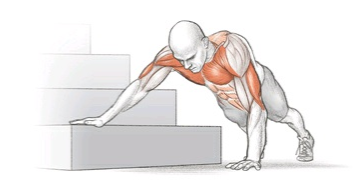Push up
Execution
1. Place your hands slightly wider than shoulder width and your feet close together on the ground with your body in a straight line from heels to head.
2. With the arms at a 45-degree angle, the hands positioned directly under the elbows, the glutes and abs contracted, and the entire body tight, lower yourself until your chest
touches the ground.
3. Reverse the movement and raise your body until your elbows lock out.
Muscles Involved
Primary: Pectoralis major, triceps brachii, anterior deltoid
Secondary: Serratus anterior, trapezius, rectus abdominis
Exercise Notes Second to the biceps, the pectoralis major is the muscle men most want to develop, as evidenced by our obsession with push-ups and bench presses. But this exercise isn’t all show and no go. Push-ups build upper-body strength and power, which transfers to punching and pushing power. Make this a full-body exercise by engaging the core and keeping the glutes squeezed as tightly as possible throughout the set. Many people sag at the hips, place their elbows too wide, and fail to use a full range of motion. By engaging the glutes and abs, you’ll prevent the hips from sagging. Place your arms at a 45-degree angle from your body (abducted position) and make sure your forearms and hands are directly under the elbows for maximum shoulder joint health. Look down to keep the neck in neutral position. Lower all the way and come up all the way for correct performance, which allows you to also strengthen the shoulder stabilizers and keep the shoulders healthy for years to come.
Variation of push ups
Wide-Width Push-Up
The wide-width push-up targets the pectoralis muscles differently than the regular push-up. To perform this movement, place the hands higher and wider on the floor compared to the standard version.
Elevated Push-Up
Execution
1. Place your feet on top of a couch, chair, or box and your hands on top of two chairs positioned slightly wider than shoulder-width apart. You also could use objects such as a weight bench and two sturdy boxes.
2. Keeping the body in a straight line and glutes tight, descend until you feel a stretch in
your pecs.
3. Reverse the movement and push your body up until your elbows lock out.
Muscles Involved
Primary: Pectoralis major, triceps brachii, anterior deltoid
Secondary: Serratus anterior, trapezius, rectus abdominis
Exercise Notes The elevated push-up is an advanced variation of the push-up, allowing an increased range of motion at the shoulder joint. This equates to more muscle activation and ultimately more muscle mass. You don’t want to aggravate the shoulder joint, so go only a few inches or centimeters deeper than you would during normal push-ups. The forearms should remain perpendicular to the floor and the hands placed at a medium width.
Side-to-Side Push-Up
Execution
1. Begin in a standard push-up position, feet close together with toes on the floor, hands under shoulders.
2. As you descend into the push-up, lean to one side, placing more stress on the side that you’re leaning toward.
3. Push up to lockout and alternate on the other side.
Muscles Involved
Primary: Pectoralis major, triceps brachii, anterior deltoid
Secondary: Serratus anterior, trapezius, rectus abdominis
Exercise Notes The side-to-side push-up is an advanced variation that places more stress on the targeted side. The side you are targeting will take on about 65 percent of the load while the other side will take on about 35 percent. Moreover, this variation provides a challenging core workout because it’s difficult to maintain proper body position throughout the movement. Try to resist excessive lateral and rotary spinal motion during the set.
One-Arm Push-Up
Execution
1. Take a wider-than-normal stance. Place one arm under your body and grab your upper outer leg with the nonworking arm.
2. Lower your body while keeping the grounded arm tucked in close to the torso, keeping the body straight, the core tight, and the hips square.
3. Lift yourself to lockout while preventing excessive lateral and twisting motions.
Muscles Involved
Primary: Pectoralis major, triceps brachii, anterior deltoid
Secondary: Serratus anterior, trapezius, rectus abdominis, internal oblique, external oblique
Exercise Notes The one-arm push-up is the most challenging push-up variation included in this book. It is very difficult. Build up to performing this movement by starting with a short-lever position from the knees or from a torso-elevated position with the hand on a sturdy table or chair. Also you can simply lower your body by performing controlled negatives (lower yourself slowly) until you’re able to push yourself back up properly. Control the side-to-side and rotary motions with strong core contractions.
Self-Assisted One-Arm Push-Up
You can perform self-assisted one-arm push-ups by placing one hand on top of a sturdy chair, weight bench, or stair and relying on the other arm, hand on the ground, as much as possible to execute the push-up. The hand on the chair or bench provides the minimum amount of resistance to help you achieve the repetition. This is an effective movement and serves as a valuable intermediate exercise between two-arm push-ups and one-arm push-ups.









Post a Comment